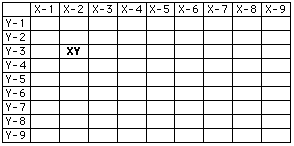

In this approach [1,2], pools of compounds are screened instead of isolated pure compounds. The library can be envisioned as a grid composed of 9 X 9 cells (Table 1), each cell representing one compound (substituents X1- X9 from the X design set and substituents Y1 - Y9 from the Y design set). For example, the cell designated as XY in Table 1 would have substituent "2" for X and substituent "3" for Y. The compounds would be synthesized and screened as mixtures. The rows and columns from Table 1 represent separate mixtures of nine compounds each. For example, column X-4 would be a mixture of nine compounds (Y = substituents 1-9) all having substituent 4 at X. To avoid the problem of deconvolution, each compound is tested twice, once as a component of the X pools (columns) and once as a component of the Y pools (rows). The most active compounds can readily be determined by the intersection of the best of the columns with the best of the rows.

One potential problem associated with testing mixtures of compounds is the ability to differentiate pools which contain one or two highly active compounds from pools which contain many weak or moderately active compounds. This is dependent on both the potency of the compound(s) as well as on the total number of compounds in the pool.